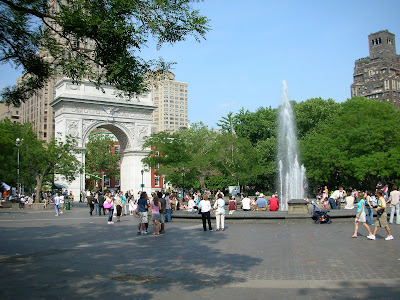Prior to 1797, the current site of Washington Square Park was farmland, when the Common Council of New York purchased the fields for a new potter's field, or public burial ground for the unknown or poor. However, when New York, which had not spread to this area yet, went through yellow fever epidemics in the early 1800's, most of those who died were also buried here, safely away from town, as a hygenic measure. It is estimated that over 20,000 bodies were buried in Washington Square, mainly the victims of yellow fever, until the cemetery became full in 1825. A number of reports exist of a blue mist hanging over the park on hot summer mornings, thought to be the 'vapors' from the bones below.
It was during this time, as legend has it, that the large elm at the northwest corner of the park was the old hanging tree where many of the condemned prisoners, from the Newgate Prison on Christopher Street and other jails were taken for execution. What is a fact is that in 1989, the NYC Department of Parks and Recreation determined that this English elm was 310 years old, making it the oldest known tree in Manhattan
In 1826 the City bought additional land, the square was laid out and leveled, and it was turned into the Washington Military Parade Ground. Military parade grounds were public spaces specified by the city where volunteer militia companies responsible for the nation's defence would train. The streets surrounding the square became one of the city's most desirable residential areas in the 1830's. The protected row of Greek Revival style houses on the north side of the park remain from that time.
In 1849 and 1850, the parade ground was reworked into the first park on the site with more paths and a new fence built around it.
At 9.75 acres Washington Square Park is one of the best-known of NYC's 1,700 public parks, and is a landmark in the Manhattan neighborhood of Greenwich Village, as well as a meeting place and center for cultural activity. An open space with a tradition of nonconformity, the park's fountain area has long been one of the city's popular spots for residents and tourists.




No comments:
Post a Comment